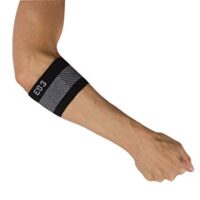Arm Pain
Article by John Miller


Arm Pain
Diagnosing, Treating, and Preventing
Experiencing arm pain can be a distressing and limiting experience, impacting your daily activities. Understanding the causes, implementing effective treatments, and taking preventive measures are crucial steps in managing this condition. This comprehensive guide, enriched with a physiotherapist’s perspective and recent research, aims to empower you with the knowledge and tools to effectively address arm pain.
Identifying the Causes of Arm Pain
Arm pain arises from various sources such as trauma, overuse, or underlying medical conditions. Commonly, it originates from the shoulder, wrist, or elbow. Accurately identifying the specific area and cause of your pain is the first step towards targeted treatment. Recent studies highlight the increasing prevalence of arm pain linked to sedentary lifestyles and prolonged use of digital devices, pointing to the need for awareness and early intervention.

Causes by Region
Shoulder Pain
Elbow Pain
Wrist and Hand Pain
Causes by Structure
Musculoskeletal Causes
Neurological Causes
Preventive Measures
Prevention is key in avoiding future arm injuries. Maintaining proper posture, using correct lifting techniques, and avoiding repetitive strain are vital. Regular exercise and stretching enhance muscle and joint health, reducing the risk of arm pain.
Ergonomic adjustments in the workplace and during recreational activities also play a crucial role in prevention.
Physiotherapy for Arm Pain
Physiotherapists play a central role in the assessment and treatment of arm pain. They use a variety of techniques, including:
- Manual Therapy: To improve mobility and alleviate pain.
- Exercise Prescription: Tailored exercises strengthen muscles and improve flexibility.
- Education: Empowering patients with knowledge about their condition and how to manage it.
Recent Advances in Physiotherapy
Recent advancements in physiotherapy, such as the use of evidence-based exercise protocols and dry needling, have shown promising results in the treatment of arm pain, offering patients more options for effective relief.
When to Consult an Orthopaedic Surgeon
In cases of severe or persistent arm pain, a referral to an orthopaedic surgeon may be necessary. They can provide specialised care and treatment options, including surgery, if required.
The Role of Lifestyle and Diet
Emerging research underscores the importance of a holistic approach to managing arm pain. Lifestyle factors like diet, stress management, and adequate sleep significantly influence recovery and pain management.
Exercises for Arm Pain
Incorporating specific exercises can greatly aid in managing and preventing arm pain. Examples include:
- Stretching: To improve flexibility and reduce muscle tension.
- Strengthening Exercises: Focusing on the affected area to enhance support and reduce the likelihood of re-injury.
Conclusion
Arm pain, while challenging, can be effectively managed with the right approach. Early diagnosis, appropriate treatment, and preventive measures are crucial. Always consult a healthcare professional, preferably a physiotherapist, for a tailored treatment plan.
Remember, managing arm pain is not just about treatment; it’s about adopting a lifestyle that supports musculoskeletal health.
Seeking Professional Advice
If you are experiencing arm pain, seek the advice of a physiotherapist. They can provide a comprehensive assessment, treatment plan, and guidance on preventive measures tailored to your specific needs.
Article by John Miller
What Causes Arm Pain?


Arm pain can arise from various factors, including sports injuries, work-related incidents, and repetitive overuse. Understanding the underlying cause is crucial for effective treatment. The causes of arm pain can be broadly categorised by region and structure, such as neck pain, shoulder pain, elbow pain, wrist pain, hand pain, arthritis, bursitis, ligament injury, muscle pain, tendinopathy, and more. It can stem from a local injury, musculoskeletal issue, or even referred from nerves in your neck.
Common Causes of Arm Pain
Shoulder Pain
Common shoulder issues include rotator cuff injuries or frozen shoulder. These conditions often result in significant discomfort and restricted movement. Shoulder pain can severely impact your daily activities, making it difficult to perform simple tasks.
Elbow Pain
Elbow pain is frequently caused by conditions such as tennis elbow or golfer’s elbow. These conditions are typically due to repetitive motions and overuse, leading to inflammation and pain in the tendons around the elbow joint.
Wrist and Hand Pain
Wrist and hand pain can be associated with carpal tunnel syndrome, wrist arthritis, or de Quervain’s tenosynovitis. These conditions can cause numbness, tingling, and weakness in the hands, affecting your ability to grip objects.
Importance of Professional Assessment and Prompt Treatment
Seeking professional assessment and prompt treatment for arm pain is essential. A skilled health practitioner can provide an accurate diagnosis and tailor a treatment plan to address the specific source of your arm pain. Early intervention can significantly improve outcomes and prevent further complications.
Arm pain, especially on the left side, can sometimes indicate a more serious condition, such as a cardiac issue. Therefore, it is vital to seek immediate medical attention if you experience sudden or severe left-arm pain.
Causes of Arm Pain by Region
Neck Pain
- Cervical Radiculopathy: A condition where a nerve in the neck becomes compressed or irritated, leading to pain radiating down the arm.
- Pinched Nerve: Compression of a nerve in the neck can cause arm pain and numbness.
Shoulder Pain
- Rotator Cuff Injuries: These involve damage to the muscles and tendons that stabilize the shoulder joint.
- Frozen Shoulder: Characterised by stiffness and pain in the shoulder joint, making movement difficult.
Elbow Pain
- Tennis Elbow: Inflammation of the tendons on the outer side of the elbow.
- Golfer’s Elbow: Inflammation of the tendons on the inner side of the elbow.
Wrist Pain
- Carpal Tunnel Syndrome: Compression of the median nerve within the wrist, leading to pain and numbness in the hand.
- Wrist Arthritis: Degeneration of the joints in the wrist causing pain and stiffness.
Hand Pain
- Finger Sprain: Stretching or tearing of the ligaments in the fingers.
- Hand Arthritis: Inflammation of the joints in the hand, leading to pain and reduced function.
Causes of Arm Pain by Structure
Arthritis
Arthritis is inflammation of the joints, causing pain and stiffness.
Bursitis
Bursitis is inflammation of the bursa, a fluid-filled sac that reduces friction between tissues.
Ligament Injury
Injury to the ligaments, which connect bones and provide stability to joints.
Muscle Pain
Pain originating from muscles due to overuse, strain, or injury.
Tendinopathy
Disorders of the tendons, including tendinitis (inflammation) and tendinosis (degeneration).
What to Do?
If you experience arm pain, it is crucial to seek professional advice from a physiotherapist or doctor. Early diagnosis and treatment can prevent complications and promote a quicker recovery. Physiotherapists can offer various treatments, including manual therapy, exercises, and advice on lifestyle modifications to alleviate pain and improve function.
Conclusion
Arm pain can have many causes, ranging from injuries to underlying health conditions. Seeking professional assessment and treatment is vital to managing pain effectively and preventing further issues. Don't ignore persistent arm pain; consult your physiotherapist or doctor for a tailored treatment plan.
Arm Pain FAQs
1. What are the common causes of arm pain? Common causes include shoulder injuries, elbow conditions like tennis elbow, and wrist issues such as carpal tunnel syndrome.
2. When should I see a physiotherapist for arm pain? Seek professional help if you experience persistent or severe arm pain, especially if it affects your daily activities.
3. Can arm pain be a sign of a serious condition? Yes, left-arm pain can sometimes indicate a cardiac issue. Seek immediate medical attention if you experience sudden or severe left-arm pain.
4. How is arm pain diagnosed? A physiotherapist will assess your symptoms, medical history, and may perform physical tests to diagnose the cause of your arm pain.
5. What treatments are available for arm pain? Treatments can include manual therapy, exercises, and advice on modifications to daily activities to reduce pain and improve function.
6. Can lifestyle changes help reduce arm pain? Yes, modifying activities that strain the arm, using ergonomic tools, and incorporating regular exercise can help manage and reduce arm pain.
Related Articles
- Shoulder Pain: Causes and Treatments - Explore various causes and treatments for shoulder pain.
- Tennis Elbow: Symptoms and Management - Learn about symptoms and effective management strategies for tennis elbow.
- Carpal Tunnel Syndrome: Diagnosis and Therapy - Discover how carpal tunnel syndrome is diagnosed and treated.
- Frozen Shoulder: Understanding and Treatment Options - Find out more about frozen shoulder and its treatment.
- Cervical Radiculopathy: Causes and Relief - Understand the causes of cervical radiculopathy and relief options.
- Wrist Arthritis: Symptoms and Solutions - Learn about the symptoms and solutions for wrist arthritis.
- Rotator Cuff Injuries: Prevention and Care - Explore prevention and care strategies for rotator cuff injuries.
- Golfer’s Elbow: Recognising and Managing - Understand how to recognise and manage golfer’s elbow.
- Thoracic Outlet Syndrome: Symptoms and Treatment - Discover symptoms and treatment options for thoracic outlet syndrome.
- Hand Arthritis: Managing Pain and Stiffness - Find out how to manage pain and stiffness caused by hand arthritis.
- Causes of Arm Pain - WebMD discusses various causes of arm pain and when to seek medical attention.
- Arm Pain: Causes, Diagnosis, and Treatment - Healthline provides a comprehensive overview of arm pain, including causes and treatment options.
- Arm Pain: When to See a Doctor - Mayo Clinic explains when arm pain might indicate a more serious condition and when to seek medical care.
Elbow Pain Causes, Diagnosis, and Effective Physiotherapy Management
Introduction
Elbow pain, a common ailment affecting people of all ages, can disrupt daily activities and diminish quality of life. This article, informed by physiotherapist insights, explores the various causes of elbow pain, emphasising the importance of early diagnosis, accurate assessment, and tailored physiotherapy interventions.
Understanding Elbow Pain
Elbow pain can stem from various sources, ranging from tendinopathy to nerve compression. Identifying the root cause is key to selecting the most effective treatment.


Common Elbow Pain Causes
Tennis Elbow and Golfer's Elbow:
Tennis Elbow and Golfer's Elbow, caused by overuse or strain of the elbow tendons, are prevalent among athletes and those engaging in repetitive arm movements. More info: Tennis Elbow, Golfer Elbow.
Olecranon Bursitis:
Olecranon Bursitis is inflammation of the bursa near the elbow joint leads to pain and swelling.
Youth Elbow Pain:
Conditions like Thrower's Elbow and Little League Elbow are common in young athletes due to repetitive stress. More info: Youth Arm Pain
Neck-Related Arm Pain:
Issues in the neck, like Cervical Radiculopathy or Neck Arm Syndrome can manifest as elbow pain.
Muscle-Related Pain:
Muscle strains and repetitive strain injuries (RSI) often present as elbow discomfort.
Medical Conditions:
Stress fractures, fibromyalgia, and various types of arthritis can also lead to elbow pain.
Recent Research Insights
Recent studies highlight the effectiveness of targeted physiotherapy in treating elbow pain. Techniques such as manual therapy, specific exercises, and other therapies have shown promising results in reducing pain and improving function.
The Role of Physiotherapy in Treating Elbow Pain
Physiotherapy plays a crucial role in the management of elbow pain, focusing on alleviating discomfort and restoring normal function.
Key Physiotherapy Interventions
- Personalised Exercise Programs: Tailored exercises to strengthen and stretch the affected muscles.
- Manual Therapy: Hands-on techniques to improve joint mobility and reduce pain.
- Pain Management: Use of modalities like ice, heat, and ultrasound to manage pain and inflammation.
- Education and Advice: Guidance on activity modification and ergonomics to prevent recurrence.
The Importance of Early Intervention
Early physiotherapy intervention can prevent the progression of symptoms and facilitate a quicker return to daily activities.
When to Seek Professional Advice
Consult a physiotherapist or doctor if you experience persistent or worsening elbow pain. They can conduct a comprehensive assessment and develop a personalised treatment plan.
What to Do?
If you're experiencing elbow pain:
- Rest: Avoid activities that exacerbate the pain.
- Apply Ice: To reduce swelling and pain.
- Seek Professional Help: A physiotherapist can provide expert advice and treatment.
Conclusion
Elbow pain, though common, can be effectively managed with physiotherapy. Understanding the cause, seeking early treatment, and adhering to a personalised care plan are vital for a successful recovery.
For more detailed information on elbow pain causes and treatments, visit PhysioWorks, where you can find resources and professional advice tailored to your condition.































































